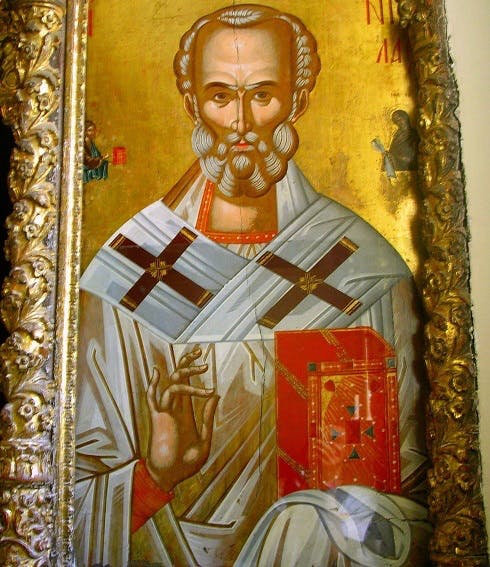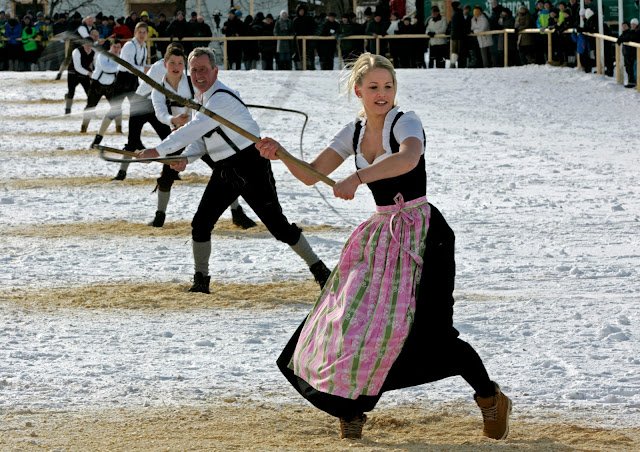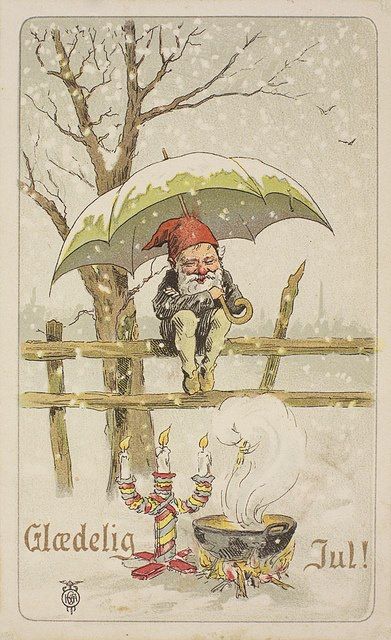On Monday, it was the Feast Day of Saint Nicholas. The event is celebrated around the world. In commemoration, I'll share some colorful information about the venerated saint. He is dually famous as a churchly saint and a gift-giver. Over the centuries, depictions of him morphed into Santa Claus. But that is not the same as Father Christmas. I shall explain.
This is a piece of iconography that depicts Saint Nicholas.
Before the Church gave him sainthood, he was known as Nicholas of Myra. He was a bishop/nobleman in ancient Greece who died in 343 AD. Commemorating his deeds, he is known as the patron saint of seafarers and children.
In Dutch, his name is Sinterklaas, and his arrival in the Netherlands is celebrated during each mid-November. He is the patron saint of the kingdom's capital: Amsterdam.
Dressed as a bishop, Sinterklaas rides a white horse and is assisted by Black (Sooty) Petes. He is greeted by each mayor, and Dutch media enjoy plenty of his escapades beforehand.
He bestows edible treats and small gifts to good children. Untainted by the legend of Santa Claus, he remains the mainstay of Dutch culture during Christmastime and bestows his gifts on December 5.
Perhaps the popularity of Sinterklaas outshines Santa in the Netherlands because he was a main inspiration for Santa Claus. "Santa Claus" derives from the Dutch original: "Sinterklaas". In the 1640s, employees of the Dutch West India Company brought the notion of Sinterklaas to North America, and it morphed into Santa Claus. Both fictitious men confer gifts to good people.
Other societies "believe" in Saint Nicholas: Austria, Belgium, Costa Rica, Croatia, Czech Republic, Germany, Italy, Indonesia, Luxembourg, Poland, Romania, Slovenia, Switzerland, (and Hong Kong).
In some of those countries, the folklore of St. Nick involves him rewarding good children, while a horrific creature punishes bad ones. Its origins are pre-Christian, but its presence was not squashed by Christianization. In Slavic and Alpine regions (such as Austria), the horned/fanged creature is named Krampus. He and St. Nick visit households on December 5.
Some anthropologists prove that the origins of Krampus come from New Year revelry. Long before the emergence of Christianity, it was customary to ignite communal bonfires, as an end-of-year ritual to welcome the new “light”. To scare away evil spirits, pagan revelers made lots of noise, which formed the basis for contemporary fireworks during New Year’s Eve. (Inventing fireworks in 200 BC, the Chinese used them during Lunar New Year for the same reason).
In Tyrol, historic gunners announce the arrival of the Christ child and the New Year by firing their antique short-barreled guns. Before the invention of firearms in the 1300s, the ritual began with bells as a pagan rite to reawaken Nature from winter into spring.
In other nations, St. Nick whacks naughty children with birch branches...
...or he abducts them in his sack.
In Switzerland, Saint Nicholas is paired with Schmutzil, who is the disciplinarian for bad children.
In Russia, the fable involves Grandfather Frost who goes door-to-door and delivers toys to children. He is often accompanied by the Snow Maiden named Snegurochka. Her character derives from older Slavic mythology.
Most Americans visualize Santa Claus with a team of eight magical reindeer. Two of them are named for the Dutch words of thunder and lightning: Donder and Blitzen. (Being a mere one-time illustration in a 1939 booklet, Rudolph the Red-Nosed Reindeer was not included in the original team). In 1823, the flying reindeer were introduced in an American poem by Clement Clarke Moore, titled A Visit From Saint Nicholas. (The quantity might be inspired by the eight-legged reindeer that the Nordic god, Odin, rode). Before that, an 1812 narrative by Washington Irving mentioned Santa riding in a flying wagon.
More importantly, hordes of people overlook the fact that Moore's story describes St. Nick's sleigh as "miniature" and his reindeer are "tiny". Even though most of that story became permanent for other tales of Santa, his minuscule size was ignored.
The notion of Santa relying on laborious elves did not occur until 1873 by an American magazine named Godey's Lady's Book. Elves are supernatural woodland entities, but they are not small. What Americans mislabel as "elves in the North Pole" were actually derived from Nordic nisse (similar to gnomes). (All three of them are pre-Christian entities). Wearing red pointy hats, the diminutive nisse are guardians of homes/property. They are rewarded by people with food.
A later variant appeared in Germany in 1826 as heinzelmännchen who did the work of humans overnight.
Neither of them are associated with Saint Nicholas, yet Americans were culturally-ignorant and used them to explain how Santa accomplished many tasks.
Furthermore, the first publication about Santa in America called him "a jolly old elf", instead of a man.
Kris Kringle was an Americanized spelling of Christkindl: a “Christ child” gift-giver that is popular in Central Europe and Latin America. Clueless of the child character, Americans thought of Kris Kringle as a synonym for Santa Claus.
Using their own collective theory, many European cultures (and consequently Latin American ones) prefer to revere a character named Father Christmas. The French call him Père Noël. Central and South Americans call him Papa Noël. "Father Christmas" is honored in Argentina, Afghanistan, Peru, Albania, Australia, Belgium, Bolivia, Brazil, Bulgaria, China, Colombia, Dominican Republic, Ecuador, Egypt, Haiti, India, Hungary, Ireland, New Zealand, Paraguay, Portugal, Romania, South Africa, Spain, Syria, Taiwan, Turkey, Vietnam, the United Kingdom, and the Baltic nations of Latvia and Estonia.
Until the 1830s, illustrations of Father Christmas resembled a pagan Norse deity (like the Nordic/Scandinavian god, Odin) carrying yule logs and wassail bowls.
Yuletide festivities originated in Germanic polytheism to show gratitude for life during the midwinter solstice.
They inspired Charles Dickens’ description of the Ghost of Christmas Present in his book, A Christmas Carol.
Father Christmas and Sinterklaas were trim-bodied men, but Santa Claus was a fat man lured into people’s homes with cookies. Sinterklaas never gained popularity in the United Kingdom, but eventually, the American legend of Santa Claus reached the UK and got jumbled with Father Christmas.
For the longest time, Father Christmas and Santa Claus were depicted wearing a variety of colored garb: purple, white, pink, green, dark-blue, light-blue, and yellow. Moore's 1823 poem described Santa as “dressed in fur from his head to his foot”... but no color was mentioned. So, he was depicted with a variety of colors and patterns. (Notice the various languages).
Alas, twentieth-century Americans pigeonholed him into only wearing red fabric with white fur trim. In the 1930s, the global American corporation, Coca-Cola (which began by including cocaine to lure drinkers but stopped in 1920), hired a Scandinavian illustrator named Haddon Sundblom to make Santa their “brand mascot” to lure buyers. Before that, Sundblom was known for drawing scantily-clad pin-up girls in striptease poses. Exploiting Santa to sell merchandise was done by many corporations because they did not have to pay a real celebrity to endorse their low-value products.
The American conglomerate, Lucky Strike, utilized Santa Claus to promote its fatally-addictive cigarettes, as did R.J. Reynolds for its brand: Camel cigarettes. Making Santa’s clothes match Coca-Cola’s corporate colors kept him in red/white outfits. Thanks to Coke's global advertising and marketing campaigns, impressionable people forgot about Santa’s previous wardrobe and only thought of him wearing red. America’s entertainment industry cemented that conception via countless films and books.
Watch this quick video and turn the sound on...
Thankfully, some cultures withstand the USA's advertising/peer pressure and uphold their cultural traditions. Unfortunately, when most Americans see Santa dressed in an alternate color, they scoff and ridicule... instead of realizing that it was their culture that overruled other nations' histories.
Lewis and I have a friend from China who remarked, “From my cultural perspective, I grew up in China thinking that Santa wore historical Chinese outfits: trimmed in fur and colored red for prosperity.” Historically, those were outfits that were auspicious to wear... so, consider that, too. :-)
On the topic of Christmas, if you would like to read by adventure novel (set during Christmastime), please use this link:
https://halfwindsorfullthrottle.blogspot.com/2020/11/i-published-my-fifth-book.html
To see my pictorial version of the Santa tale, 'Twas the Night Before Christmas, please use this link:
https://halfwindsorfullthrottle.blogspot.com/2018/12/twas-night-for-pictures.html

































































































No comments:
Post a Comment
Don't be shy: leave your comments :)